University of Bedfordshire: GSK Global Operations Evaluation Report
VerifiedAdded on 2021/04/29
|16
|4084
|101
Report
AI Summary
This report provides a critical evaluation of GlaxoSmithKline's (GSK) global operations management, focusing on supply chain management, quality, and process & capacity design. It utilizes GSK as a case study, comparing it to competitor Sanofi using the 4Vs typology (Volume, Variety, Variation in Demand, and Visibility). The report examines GSK's strategic operations, including innovation, trust, and performance, and how these elements are reflected in their supply chain, quality management, and capacity strategies. The analysis incorporates concepts from Operations and Project Management, supported by academic sources, to assess GSK's operational efficiency and performance within the global healthcare landscape. Recommendations are made for improvement. The report highlights GSK's commitment to innovation, high-quality products, and efficient operations, discussing their strategies for supply chain management, quality control, and capacity expansion, including their investments in advanced manufacturing facilities and technologies. The study concludes with an overview of the key findings and provides insights into how GSK can maintain its competitive edge in the healthcare industry.
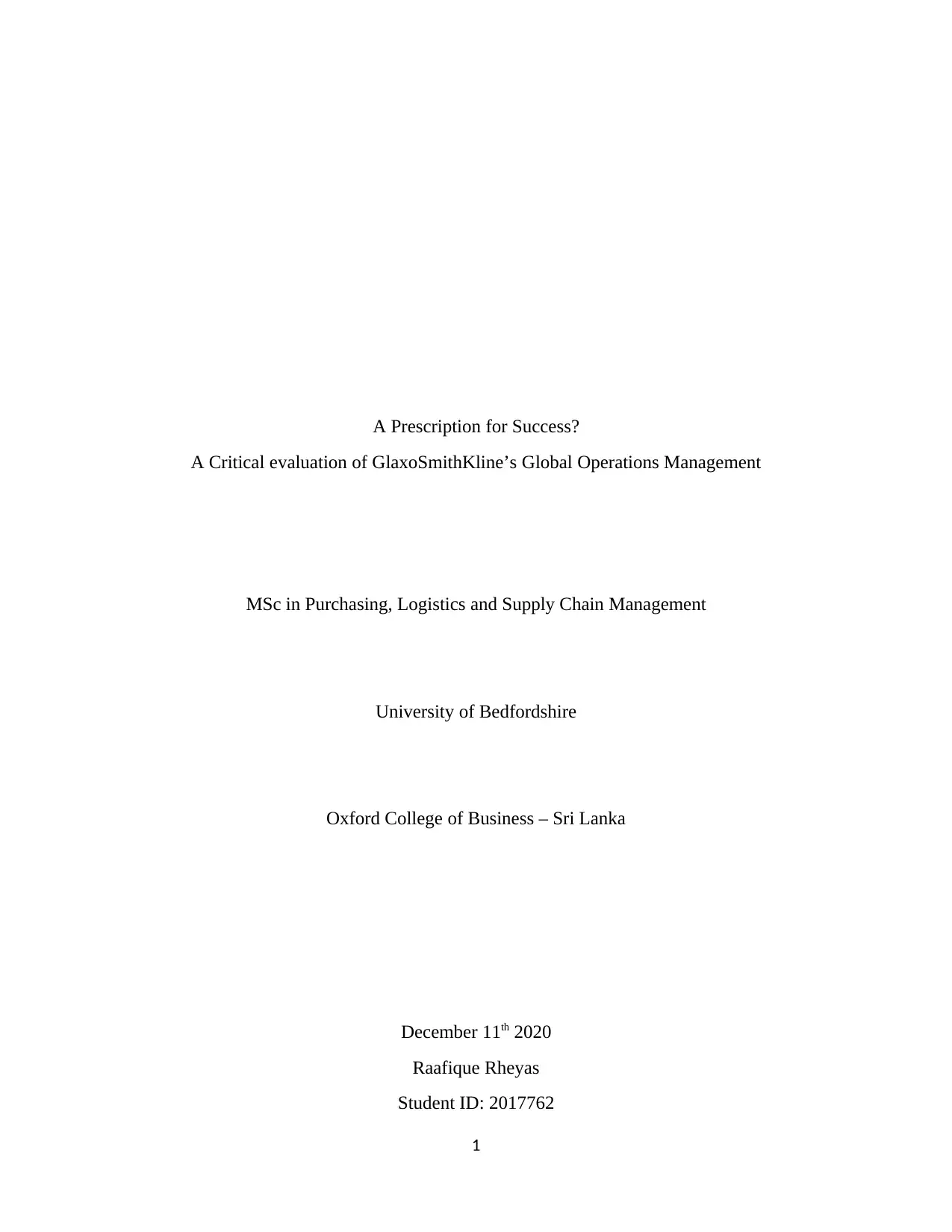
A Prescription for Success?
A Critical evaluation of GlaxoSmithKline’s Global Operations Management
MSc in Purchasing, Logistics and Supply Chain Management
University of Bedfordshire
Oxford College of Business – Sri Lanka
December 11th 2020
Raafique Rheyas
Student ID: 2017762
1
A Critical evaluation of GlaxoSmithKline’s Global Operations Management
MSc in Purchasing, Logistics and Supply Chain Management
University of Bedfordshire
Oxford College of Business – Sri Lanka
December 11th 2020
Raafique Rheyas
Student ID: 2017762
1
Paraphrase This Document
Need a fresh take? Get an instant paraphrase of this document with our AI Paraphraser
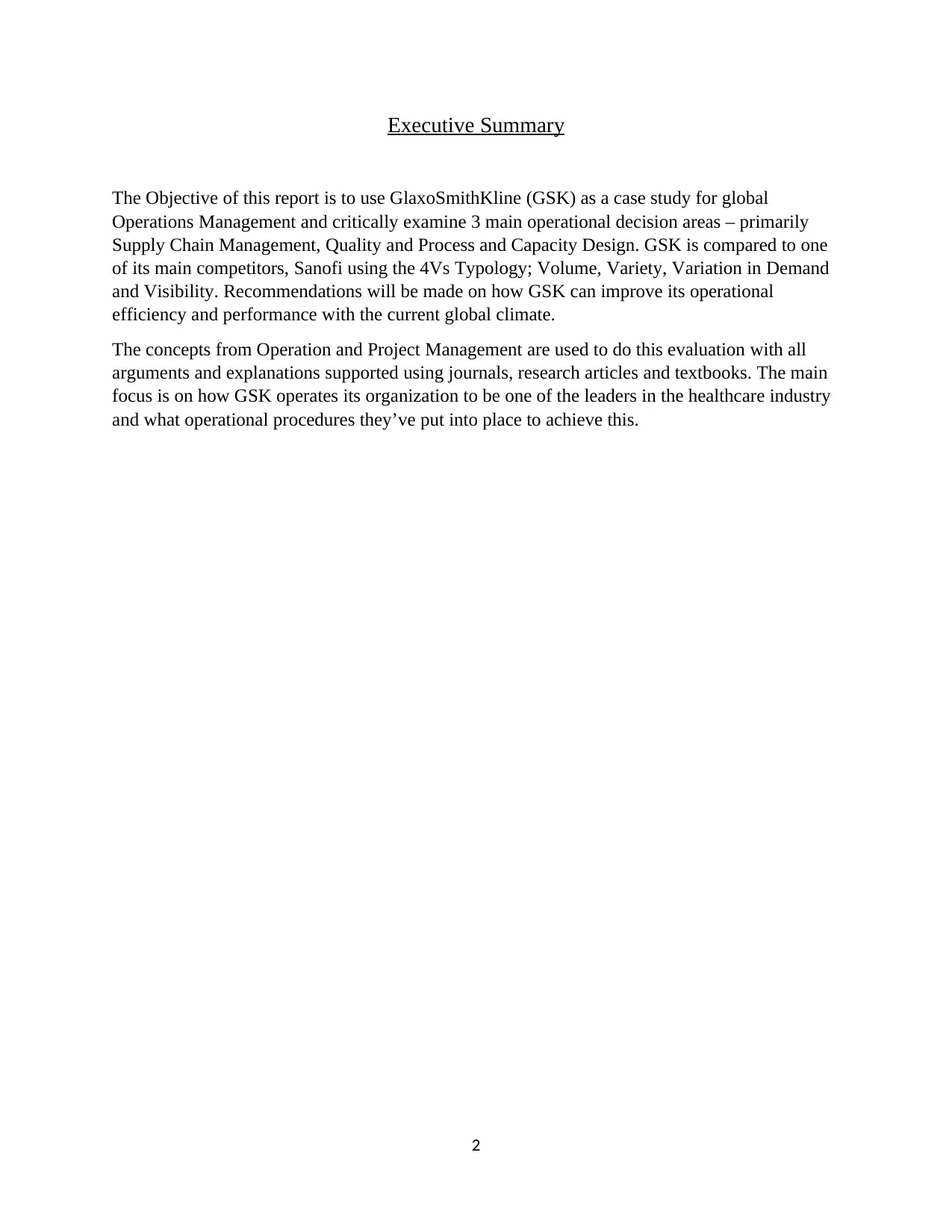
Executive Summary
The Objective of this report is to use GlaxoSmithKline (GSK) as a case study for global
Operations Management and critically examine 3 main operational decision areas – primarily
Supply Chain Management, Quality and Process and Capacity Design. GSK is compared to one
of its main competitors, Sanofi using the 4Vs Typology; Volume, Variety, Variation in Demand
and Visibility. Recommendations will be made on how GSK can improve its operational
efficiency and performance with the current global climate.
The concepts from Operation and Project Management are used to do this evaluation with all
arguments and explanations supported using journals, research articles and textbooks. The main
focus is on how GSK operates its organization to be one of the leaders in the healthcare industry
and what operational procedures they’ve put into place to achieve this.
2
The Objective of this report is to use GlaxoSmithKline (GSK) as a case study for global
Operations Management and critically examine 3 main operational decision areas – primarily
Supply Chain Management, Quality and Process and Capacity Design. GSK is compared to one
of its main competitors, Sanofi using the 4Vs Typology; Volume, Variety, Variation in Demand
and Visibility. Recommendations will be made on how GSK can improve its operational
efficiency and performance with the current global climate.
The concepts from Operation and Project Management are used to do this evaluation with all
arguments and explanations supported using journals, research articles and textbooks. The main
focus is on how GSK operates its organization to be one of the leaders in the healthcare industry
and what operational procedures they’ve put into place to achieve this.
2
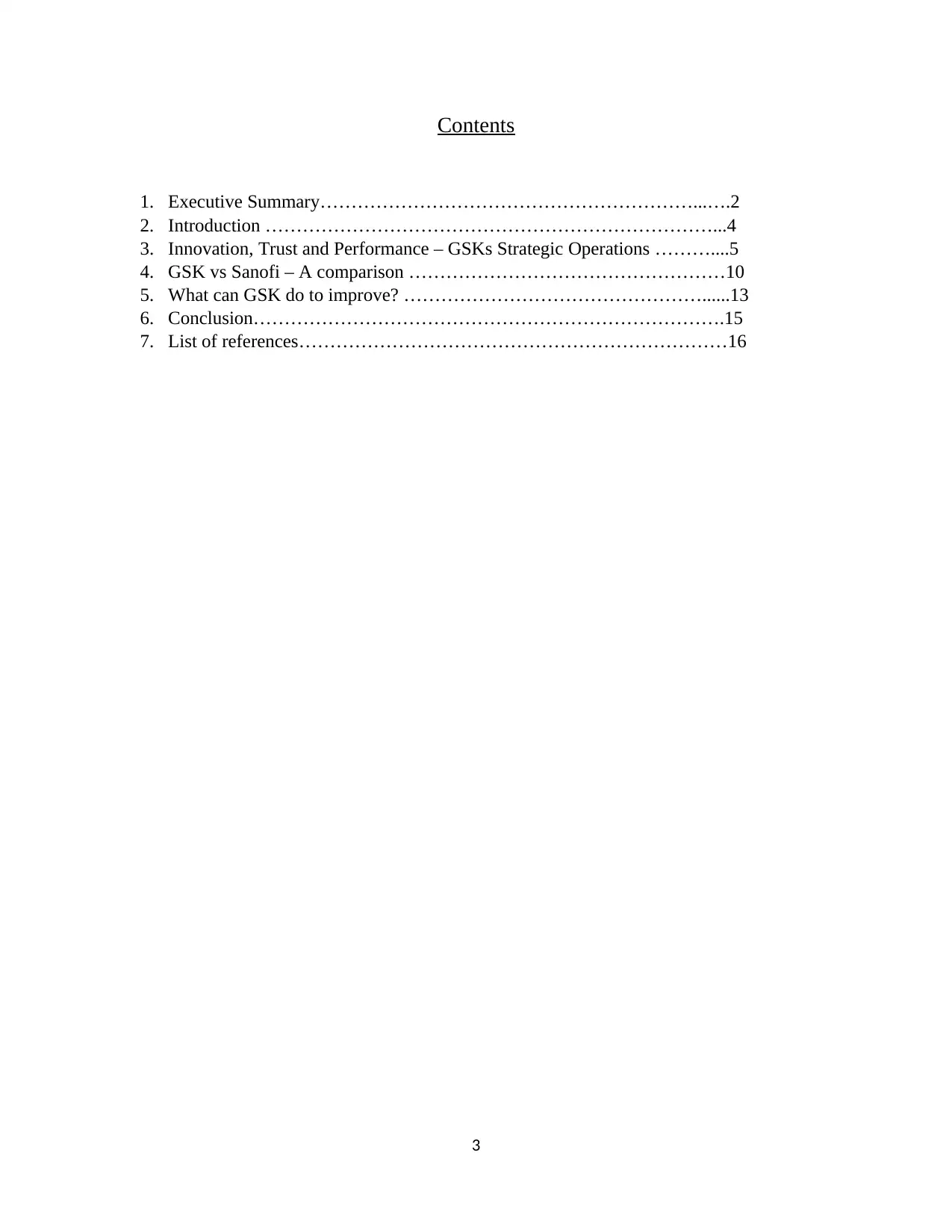
Contents
1. Executive Summary……………………………………………………...….2
2. Introduction ………………………………………………………………...4
3. Innovation, Trust and Performance – GSKs Strategic Operations ………....5
4. GSK vs Sanofi – A comparison ……………………………………………10
5. What can GSK do to improve? …………………………………………......13
6. Conclusion………………………………………………………………….15
7. List of references……………………………………………………………16
3
1. Executive Summary……………………………………………………...….2
2. Introduction ………………………………………………………………...4
3. Innovation, Trust and Performance – GSKs Strategic Operations ………....5
4. GSK vs Sanofi – A comparison ……………………………………………10
5. What can GSK do to improve? …………………………………………......13
6. Conclusion………………………………………………………………….15
7. List of references……………………………………………………………16
3
⊘ This is a preview!⊘
Do you want full access?
Subscribe today to unlock all pages.

Trusted by 1+ million students worldwide
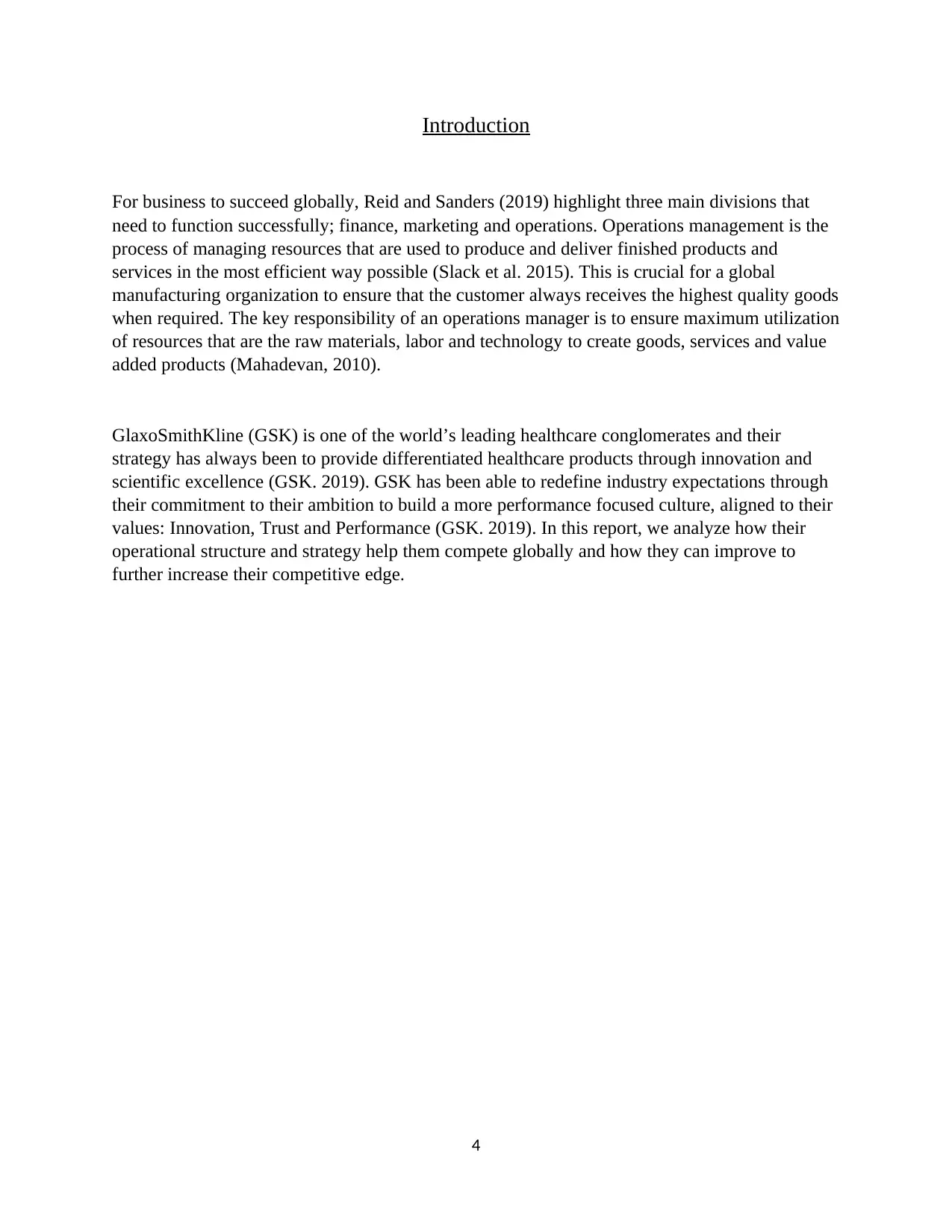
Introduction
For business to succeed globally, Reid and Sanders (2019) highlight three main divisions that
need to function successfully; finance, marketing and operations. Operations management is the
process of managing resources that are used to produce and deliver finished products and
services in the most efficient way possible (Slack et al. 2015). This is crucial for a global
manufacturing organization to ensure that the customer always receives the highest quality goods
when required. The key responsibility of an operations manager is to ensure maximum utilization
of resources that are the raw materials, labor and technology to create goods, services and value
added products (Mahadevan, 2010).
GlaxoSmithKline (GSK) is one of the world’s leading healthcare conglomerates and their
strategy has always been to provide differentiated healthcare products through innovation and
scientific excellence (GSK. 2019). GSK has been able to redefine industry expectations through
their commitment to their ambition to build a more performance focused culture, aligned to their
values: Innovation, Trust and Performance (GSK. 2019). In this report, we analyze how their
operational structure and strategy help them compete globally and how they can improve to
further increase their competitive edge.
4
For business to succeed globally, Reid and Sanders (2019) highlight three main divisions that
need to function successfully; finance, marketing and operations. Operations management is the
process of managing resources that are used to produce and deliver finished products and
services in the most efficient way possible (Slack et al. 2015). This is crucial for a global
manufacturing organization to ensure that the customer always receives the highest quality goods
when required. The key responsibility of an operations manager is to ensure maximum utilization
of resources that are the raw materials, labor and technology to create goods, services and value
added products (Mahadevan, 2010).
GlaxoSmithKline (GSK) is one of the world’s leading healthcare conglomerates and their
strategy has always been to provide differentiated healthcare products through innovation and
scientific excellence (GSK. 2019). GSK has been able to redefine industry expectations through
their commitment to their ambition to build a more performance focused culture, aligned to their
values: Innovation, Trust and Performance (GSK. 2019). In this report, we analyze how their
operational structure and strategy help them compete globally and how they can improve to
further increase their competitive edge.
4
Paraphrase This Document
Need a fresh take? Get an instant paraphrase of this document with our AI Paraphraser
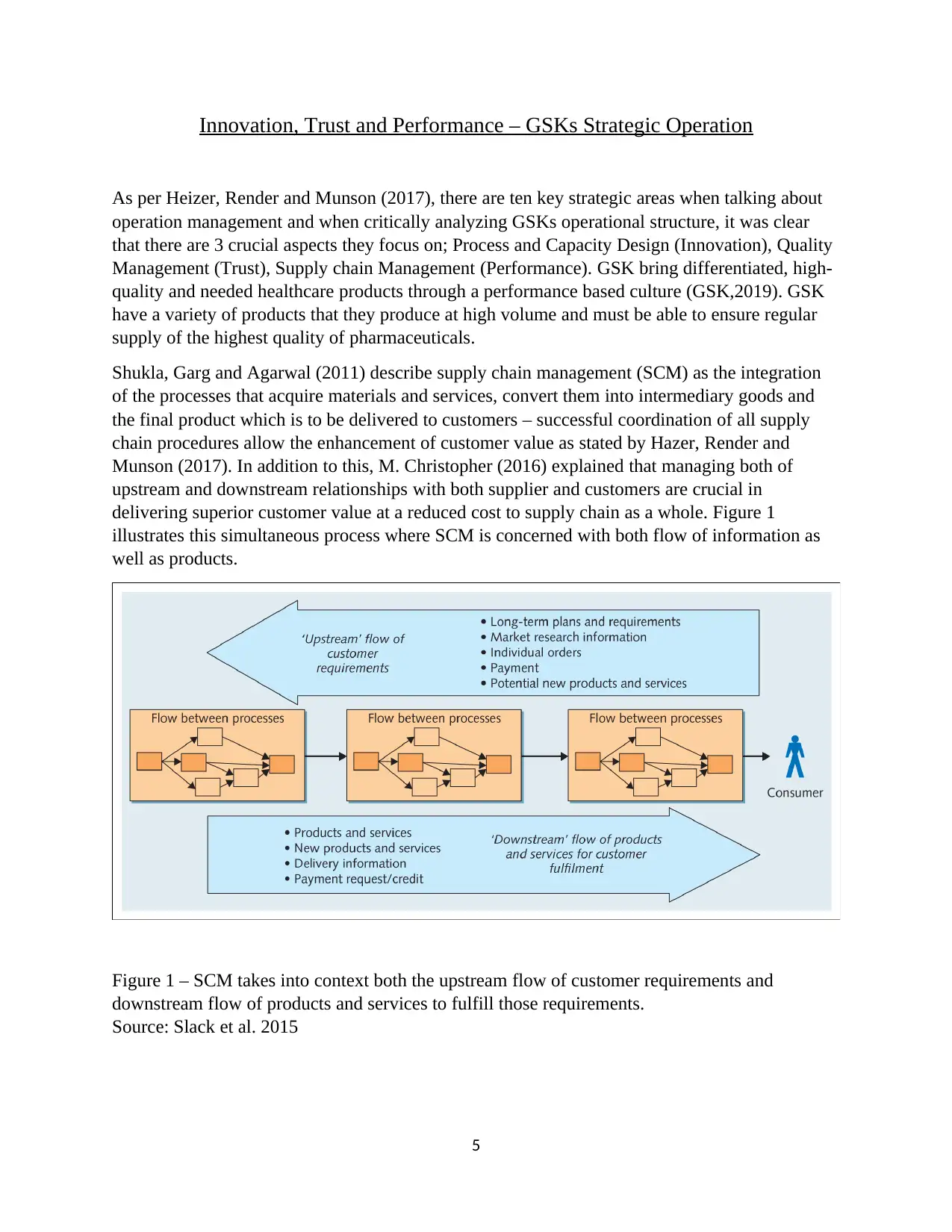
Innovation, Trust and Performance – GSKs Strategic Operation
As per Heizer, Render and Munson (2017), there are ten key strategic areas when talking about
operation management and when critically analyzing GSKs operational structure, it was clear
that there are 3 crucial aspects they focus on; Process and Capacity Design (Innovation), Quality
Management (Trust), Supply chain Management (Performance). GSK bring differentiated, high-
quality and needed healthcare products through a performance based culture (GSK,2019). GSK
have a variety of products that they produce at high volume and must be able to ensure regular
supply of the highest quality of pharmaceuticals.
Shukla, Garg and Agarwal (2011) describe supply chain management (SCM) as the integration
of the processes that acquire materials and services, convert them into intermediary goods and
the final product which is to be delivered to customers – successful coordination of all supply
chain procedures allow the enhancement of customer value as stated by Hazer, Render and
Munson (2017). In addition to this, M. Christopher (2016) explained that managing both of
upstream and downstream relationships with both supplier and customers are crucial in
delivering superior customer value at a reduced cost to supply chain as a whole. Figure 1
illustrates this simultaneous process where SCM is concerned with both flow of information as
well as products.
Figure 1 – SCM takes into context both the upstream flow of customer requirements and
downstream flow of products and services to fulfill those requirements.
Source: Slack et al. 2015
5
As per Heizer, Render and Munson (2017), there are ten key strategic areas when talking about
operation management and when critically analyzing GSKs operational structure, it was clear
that there are 3 crucial aspects they focus on; Process and Capacity Design (Innovation), Quality
Management (Trust), Supply chain Management (Performance). GSK bring differentiated, high-
quality and needed healthcare products through a performance based culture (GSK,2019). GSK
have a variety of products that they produce at high volume and must be able to ensure regular
supply of the highest quality of pharmaceuticals.
Shukla, Garg and Agarwal (2011) describe supply chain management (SCM) as the integration
of the processes that acquire materials and services, convert them into intermediary goods and
the final product which is to be delivered to customers – successful coordination of all supply
chain procedures allow the enhancement of customer value as stated by Hazer, Render and
Munson (2017). In addition to this, M. Christopher (2016) explained that managing both of
upstream and downstream relationships with both supplier and customers are crucial in
delivering superior customer value at a reduced cost to supply chain as a whole. Figure 1
illustrates this simultaneous process where SCM is concerned with both flow of information as
well as products.
Figure 1 – SCM takes into context both the upstream flow of customer requirements and
downstream flow of products and services to fulfill those requirements.
Source: Slack et al. 2015
5
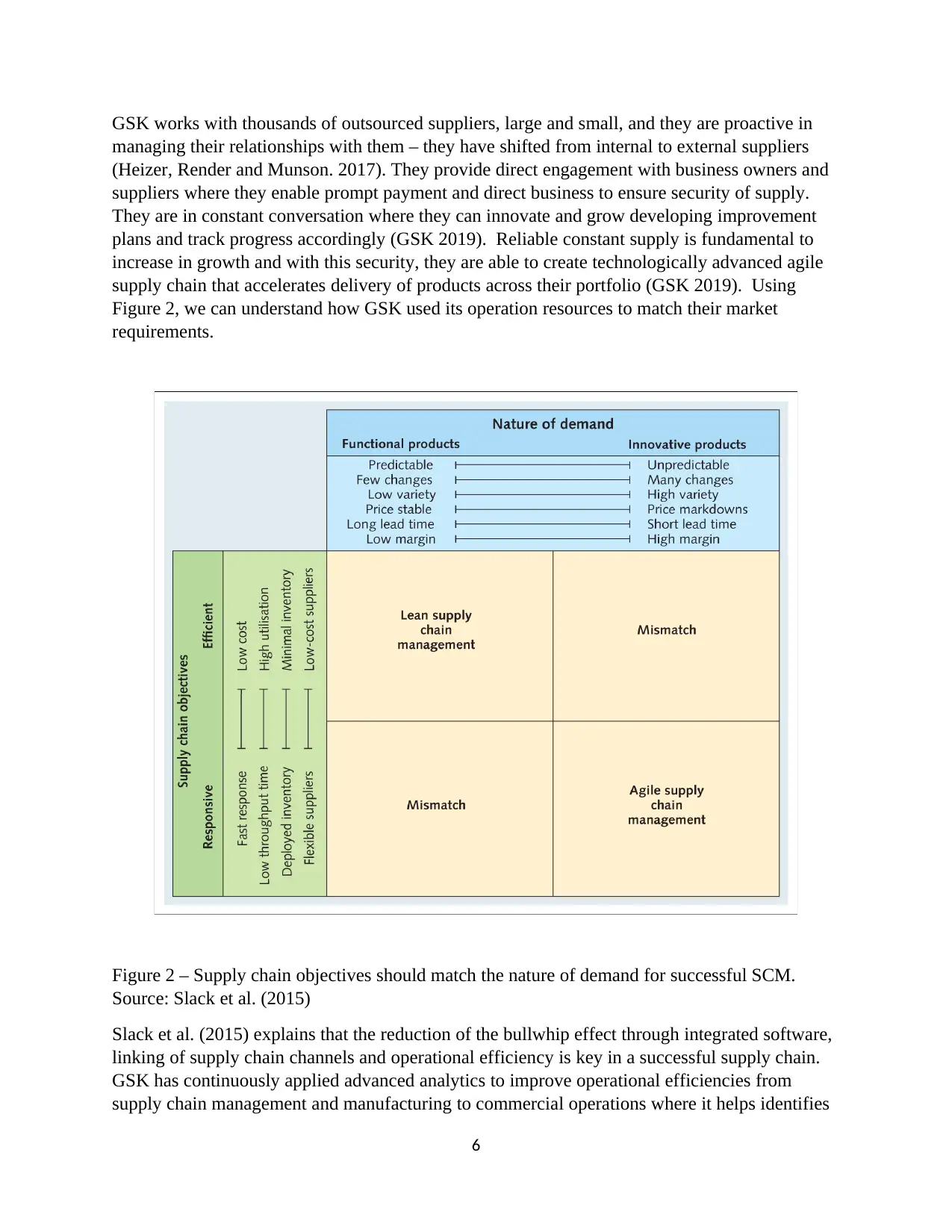
GSK works with thousands of outsourced suppliers, large and small, and they are proactive in
managing their relationships with them – they have shifted from internal to external suppliers
(Heizer, Render and Munson. 2017). They provide direct engagement with business owners and
suppliers where they enable prompt payment and direct business to ensure security of supply.
They are in constant conversation where they can innovate and grow developing improvement
plans and track progress accordingly (GSK 2019). Reliable constant supply is fundamental to
increase in growth and with this security, they are able to create technologically advanced agile
supply chain that accelerates delivery of products across their portfolio (GSK 2019). Using
Figure 2, we can understand how GSK used its operation resources to match their market
requirements.
Figure 2 – Supply chain objectives should match the nature of demand for successful SCM.
Source: Slack et al. (2015)
Slack et al. (2015) explains that the reduction of the bullwhip effect through integrated software,
linking of supply chain channels and operational efficiency is key in a successful supply chain.
GSK has continuously applied advanced analytics to improve operational efficiencies from
supply chain management and manufacturing to commercial operations where it helps identifies
6
managing their relationships with them – they have shifted from internal to external suppliers
(Heizer, Render and Munson. 2017). They provide direct engagement with business owners and
suppliers where they enable prompt payment and direct business to ensure security of supply.
They are in constant conversation where they can innovate and grow developing improvement
plans and track progress accordingly (GSK 2019). Reliable constant supply is fundamental to
increase in growth and with this security, they are able to create technologically advanced agile
supply chain that accelerates delivery of products across their portfolio (GSK 2019). Using
Figure 2, we can understand how GSK used its operation resources to match their market
requirements.
Figure 2 – Supply chain objectives should match the nature of demand for successful SCM.
Source: Slack et al. (2015)
Slack et al. (2015) explains that the reduction of the bullwhip effect through integrated software,
linking of supply chain channels and operational efficiency is key in a successful supply chain.
GSK has continuously applied advanced analytics to improve operational efficiencies from
supply chain management and manufacturing to commercial operations where it helps identifies
6
⊘ This is a preview!⊘
Do you want full access?
Subscribe today to unlock all pages.

Trusted by 1+ million students worldwide
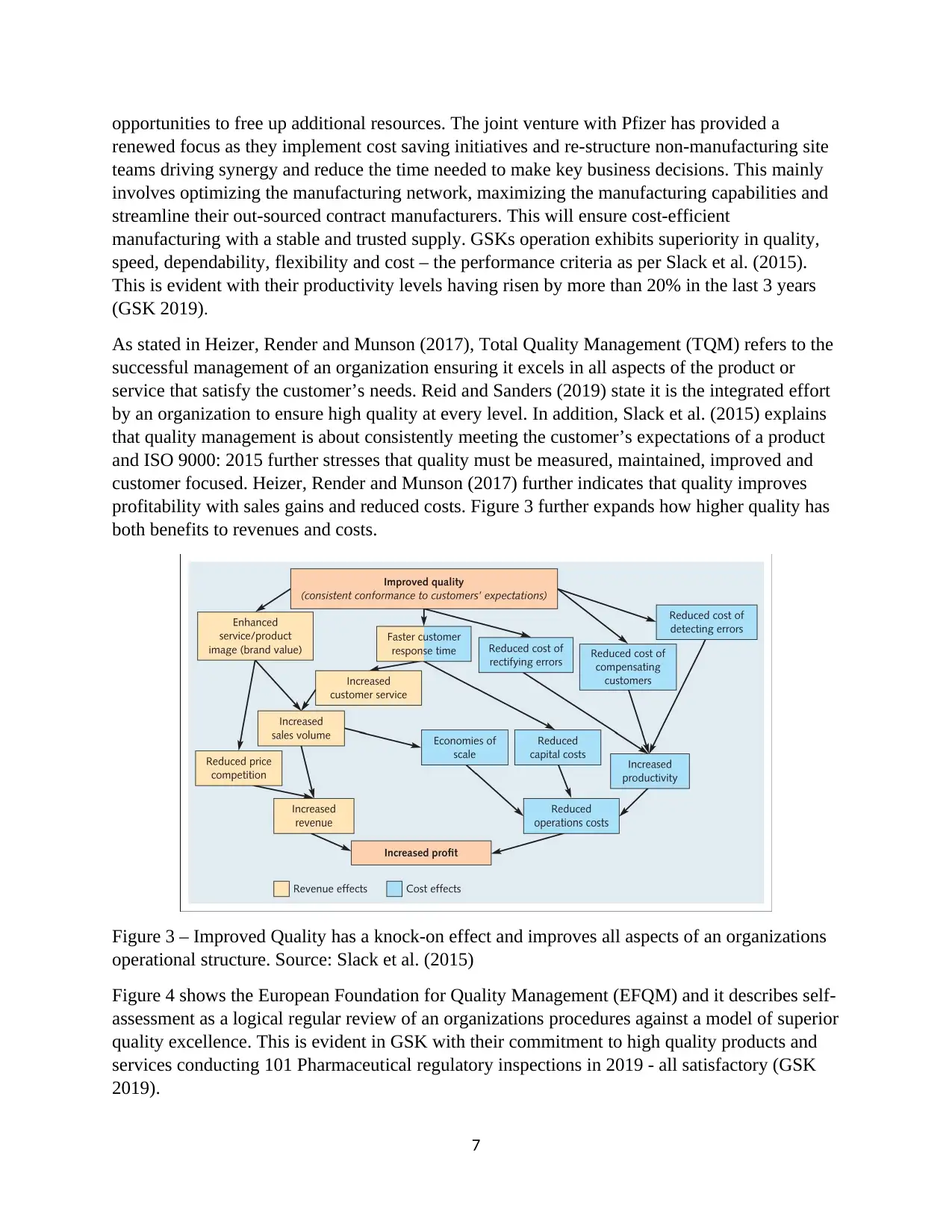
opportunities to free up additional resources. The joint venture with Pfizer has provided a
renewed focus as they implement cost saving initiatives and re-structure non-manufacturing site
teams driving synergy and reduce the time needed to make key business decisions. This mainly
involves optimizing the manufacturing network, maximizing the manufacturing capabilities and
streamline their out-sourced contract manufacturers. This will ensure cost-efficient
manufacturing with a stable and trusted supply. GSKs operation exhibits superiority in quality,
speed, dependability, flexibility and cost – the performance criteria as per Slack et al. (2015).
This is evident with their productivity levels having risen by more than 20% in the last 3 years
(GSK 2019).
As stated in Heizer, Render and Munson (2017), Total Quality Management (TQM) refers to the
successful management of an organization ensuring it excels in all aspects of the product or
service that satisfy the customer’s needs. Reid and Sanders (2019) state it is the integrated effort
by an organization to ensure high quality at every level. In addition, Slack et al. (2015) explains
that quality management is about consistently meeting the customer’s expectations of a product
and ISO 9000: 2015 further stresses that quality must be measured, maintained, improved and
customer focused. Heizer, Render and Munson (2017) further indicates that quality improves
profitability with sales gains and reduced costs. Figure 3 further expands how higher quality has
both benefits to revenues and costs.
Figure 3 – Improved Quality has a knock-on effect and improves all aspects of an organizations
operational structure. Source: Slack et al. (2015)
Figure 4 shows the European Foundation for Quality Management (EFQM) and it describes self-
assessment as a logical regular review of an organizations procedures against a model of superior
quality excellence. This is evident in GSK with their commitment to high quality products and
services conducting 101 Pharmaceutical regulatory inspections in 2019 - all satisfactory (GSK
2019).
7
renewed focus as they implement cost saving initiatives and re-structure non-manufacturing site
teams driving synergy and reduce the time needed to make key business decisions. This mainly
involves optimizing the manufacturing network, maximizing the manufacturing capabilities and
streamline their out-sourced contract manufacturers. This will ensure cost-efficient
manufacturing with a stable and trusted supply. GSKs operation exhibits superiority in quality,
speed, dependability, flexibility and cost – the performance criteria as per Slack et al. (2015).
This is evident with their productivity levels having risen by more than 20% in the last 3 years
(GSK 2019).
As stated in Heizer, Render and Munson (2017), Total Quality Management (TQM) refers to the
successful management of an organization ensuring it excels in all aspects of the product or
service that satisfy the customer’s needs. Reid and Sanders (2019) state it is the integrated effort
by an organization to ensure high quality at every level. In addition, Slack et al. (2015) explains
that quality management is about consistently meeting the customer’s expectations of a product
and ISO 9000: 2015 further stresses that quality must be measured, maintained, improved and
customer focused. Heizer, Render and Munson (2017) further indicates that quality improves
profitability with sales gains and reduced costs. Figure 3 further expands how higher quality has
both benefits to revenues and costs.
Figure 3 – Improved Quality has a knock-on effect and improves all aspects of an organizations
operational structure. Source: Slack et al. (2015)
Figure 4 shows the European Foundation for Quality Management (EFQM) and it describes self-
assessment as a logical regular review of an organizations procedures against a model of superior
quality excellence. This is evident in GSK with their commitment to high quality products and
services conducting 101 Pharmaceutical regulatory inspections in 2019 - all satisfactory (GSK
2019).
7
Paraphrase This Document
Need a fresh take? Get an instant paraphrase of this document with our AI Paraphraser
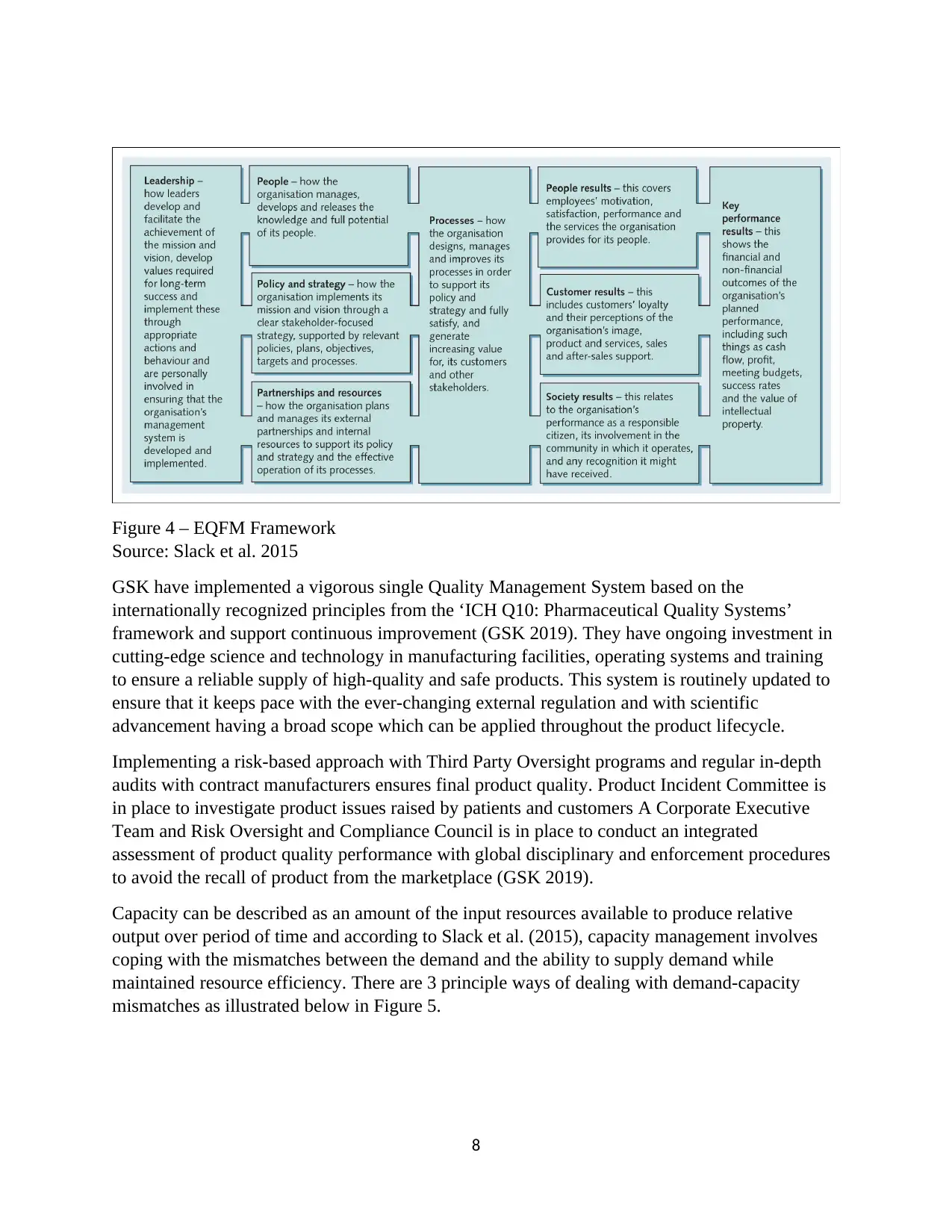
Figure 4 – EQFM Framework
Source: Slack et al. 2015
GSK have implemented a vigorous single Quality Management System based on the
internationally recognized principles from the ‘ICH Q10: Pharmaceutical Quality Systems’
framework and support continuous improvement (GSK 2019). They have ongoing investment in
cutting-edge science and technology in manufacturing facilities, operating systems and training
to ensure a reliable supply of high-quality and safe products. This system is routinely updated to
ensure that it keeps pace with the ever-changing external regulation and with scientific
advancement having a broad scope which can be applied throughout the product lifecycle.
Implementing a risk-based approach with Third Party Oversight programs and regular in-depth
audits with contract manufacturers ensures final product quality. Product Incident Committee is
in place to investigate product issues raised by patients and customers A Corporate Executive
Team and Risk Oversight and Compliance Council is in place to conduct an integrated
assessment of product quality performance with global disciplinary and enforcement procedures
to avoid the recall of product from the marketplace (GSK 2019).
Capacity can be described as an amount of the input resources available to produce relative
output over period of time and according to Slack et al. (2015), capacity management involves
coping with the mismatches between the demand and the ability to supply demand while
maintained resource efficiency. There are 3 principle ways of dealing with demand-capacity
mismatches as illustrated below in Figure 5.
8
Source: Slack et al. 2015
GSK have implemented a vigorous single Quality Management System based on the
internationally recognized principles from the ‘ICH Q10: Pharmaceutical Quality Systems’
framework and support continuous improvement (GSK 2019). They have ongoing investment in
cutting-edge science and technology in manufacturing facilities, operating systems and training
to ensure a reliable supply of high-quality and safe products. This system is routinely updated to
ensure that it keeps pace with the ever-changing external regulation and with scientific
advancement having a broad scope which can be applied throughout the product lifecycle.
Implementing a risk-based approach with Third Party Oversight programs and regular in-depth
audits with contract manufacturers ensures final product quality. Product Incident Committee is
in place to investigate product issues raised by patients and customers A Corporate Executive
Team and Risk Oversight and Compliance Council is in place to conduct an integrated
assessment of product quality performance with global disciplinary and enforcement procedures
to avoid the recall of product from the marketplace (GSK 2019).
Capacity can be described as an amount of the input resources available to produce relative
output over period of time and according to Slack et al. (2015), capacity management involves
coping with the mismatches between the demand and the ability to supply demand while
maintained resource efficiency. There are 3 principle ways of dealing with demand-capacity
mismatches as illustrated below in Figure 5.
8
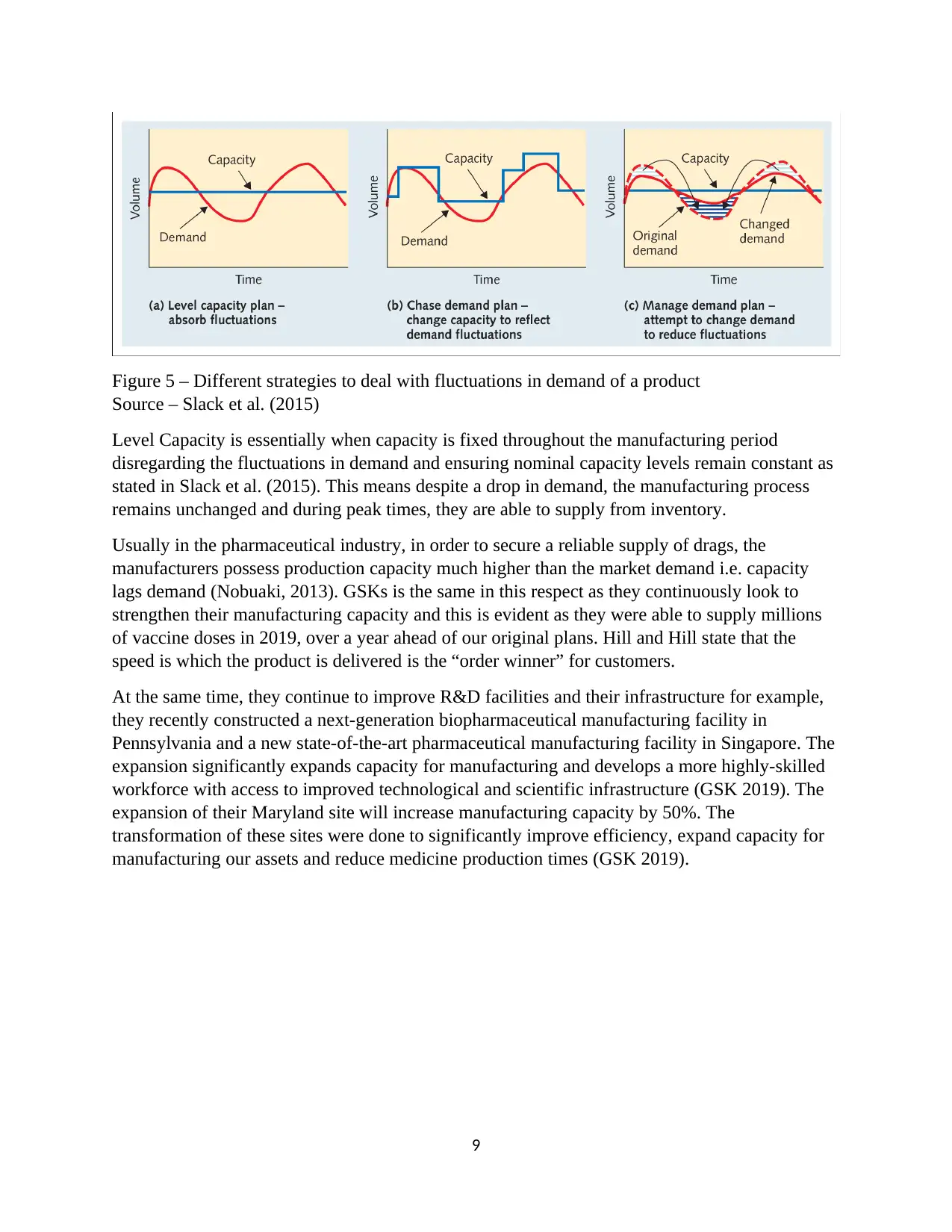
Figure 5 – Different strategies to deal with fluctuations in demand of a product
Source – Slack et al. (2015)
Level Capacity is essentially when capacity is fixed throughout the manufacturing period
disregarding the fluctuations in demand and ensuring nominal capacity levels remain constant as
stated in Slack et al. (2015). This means despite a drop in demand, the manufacturing process
remains unchanged and during peak times, they are able to supply from inventory.
Usually in the pharmaceutical industry, in order to secure a reliable supply of drags, the
manufacturers possess production capacity much higher than the market demand i.e. capacity
lags demand (Nobuaki, 2013). GSKs is the same in this respect as they continuously look to
strengthen their manufacturing capacity and this is evident as they were able to supply millions
of vaccine doses in 2019, over a year ahead of our original plans. Hill and Hill state that the
speed is which the product is delivered is the “order winner” for customers.
At the same time, they continue to improve R&D facilities and their infrastructure for example,
they recently constructed a next-generation biopharmaceutical manufacturing facility in
Pennsylvania and a new state-of-the-art pharmaceutical manufacturing facility in Singapore. The
expansion significantly expands capacity for manufacturing and develops a more highly-skilled
workforce with access to improved technological and scientific infrastructure (GSK 2019). The
expansion of their Maryland site will increase manufacturing capacity by 50%. The
transformation of these sites were done to significantly improve efficiency, expand capacity for
manufacturing our assets and reduce medicine production times (GSK 2019).
9
Source – Slack et al. (2015)
Level Capacity is essentially when capacity is fixed throughout the manufacturing period
disregarding the fluctuations in demand and ensuring nominal capacity levels remain constant as
stated in Slack et al. (2015). This means despite a drop in demand, the manufacturing process
remains unchanged and during peak times, they are able to supply from inventory.
Usually in the pharmaceutical industry, in order to secure a reliable supply of drags, the
manufacturers possess production capacity much higher than the market demand i.e. capacity
lags demand (Nobuaki, 2013). GSKs is the same in this respect as they continuously look to
strengthen their manufacturing capacity and this is evident as they were able to supply millions
of vaccine doses in 2019, over a year ahead of our original plans. Hill and Hill state that the
speed is which the product is delivered is the “order winner” for customers.
At the same time, they continue to improve R&D facilities and their infrastructure for example,
they recently constructed a next-generation biopharmaceutical manufacturing facility in
Pennsylvania and a new state-of-the-art pharmaceutical manufacturing facility in Singapore. The
expansion significantly expands capacity for manufacturing and develops a more highly-skilled
workforce with access to improved technological and scientific infrastructure (GSK 2019). The
expansion of their Maryland site will increase manufacturing capacity by 50%. The
transformation of these sites were done to significantly improve efficiency, expand capacity for
manufacturing our assets and reduce medicine production times (GSK 2019).
9
⊘ This is a preview!⊘
Do you want full access?
Subscribe today to unlock all pages.

Trusted by 1+ million students worldwide
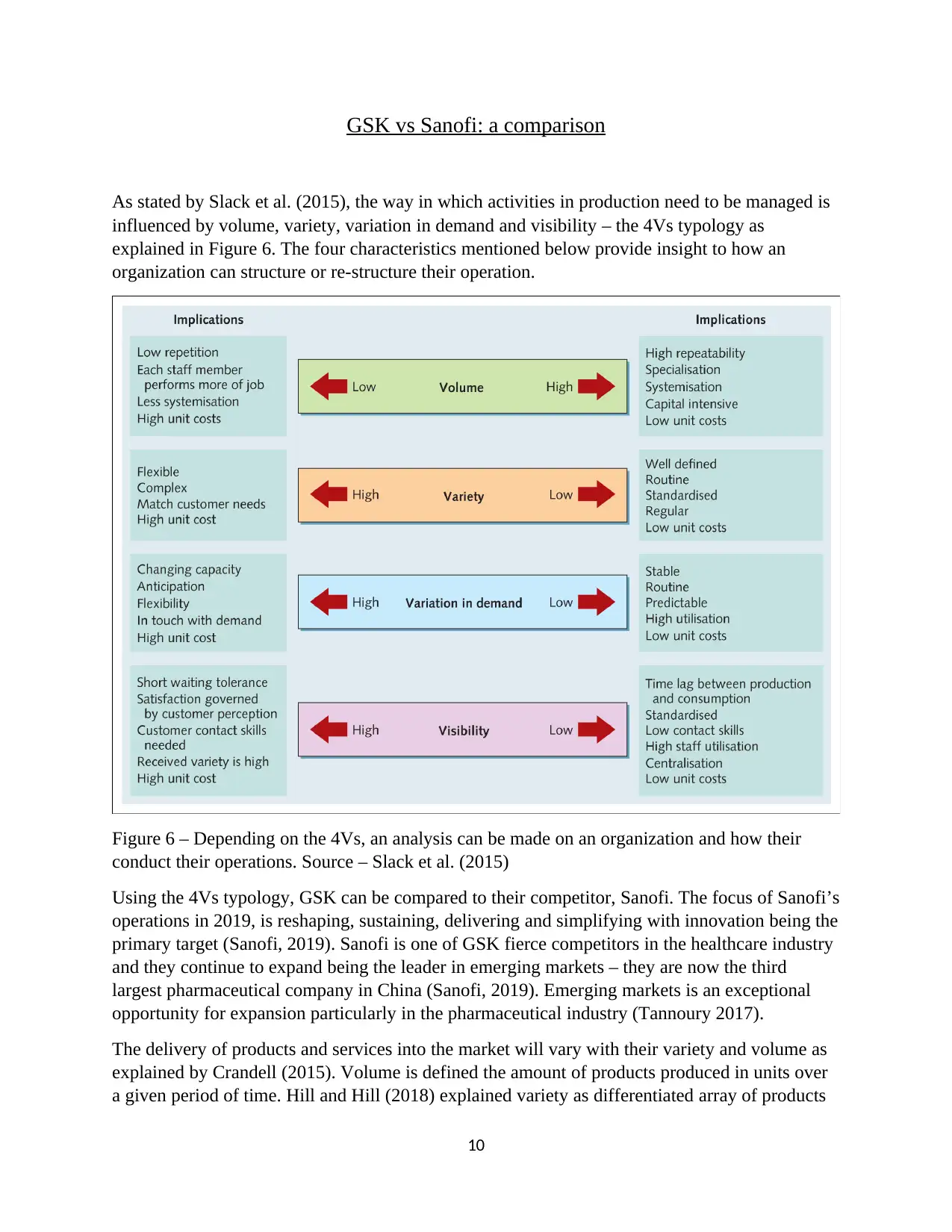
GSK vs Sanofi: a comparison
As stated by Slack et al. (2015), the way in which activities in production need to be managed is
influenced by volume, variety, variation in demand and visibility – the 4Vs typology as
explained in Figure 6. The four characteristics mentioned below provide insight to how an
organization can structure or re-structure their operation.
Figure 6 – Depending on the 4Vs, an analysis can be made on an organization and how their
conduct their operations. Source – Slack et al. (2015)
Using the 4Vs typology, GSK can be compared to their competitor, Sanofi. The focus of Sanofi’s
operations in 2019, is reshaping, sustaining, delivering and simplifying with innovation being the
primary target (Sanofi, 2019). Sanofi is one of GSK fierce competitors in the healthcare industry
and they continue to expand being the leader in emerging markets – they are now the third
largest pharmaceutical company in China (Sanofi, 2019). Emerging markets is an exceptional
opportunity for expansion particularly in the pharmaceutical industry (Tannoury 2017).
The delivery of products and services into the market will vary with their variety and volume as
explained by Crandell (2015). Volume is defined the amount of products produced in units over
a given period of time. Hill and Hill (2018) explained variety as differentiated array of products
10
As stated by Slack et al. (2015), the way in which activities in production need to be managed is
influenced by volume, variety, variation in demand and visibility – the 4Vs typology as
explained in Figure 6. The four characteristics mentioned below provide insight to how an
organization can structure or re-structure their operation.
Figure 6 – Depending on the 4Vs, an analysis can be made on an organization and how their
conduct their operations. Source – Slack et al. (2015)
Using the 4Vs typology, GSK can be compared to their competitor, Sanofi. The focus of Sanofi’s
operations in 2019, is reshaping, sustaining, delivering and simplifying with innovation being the
primary target (Sanofi, 2019). Sanofi is one of GSK fierce competitors in the healthcare industry
and they continue to expand being the leader in emerging markets – they are now the third
largest pharmaceutical company in China (Sanofi, 2019). Emerging markets is an exceptional
opportunity for expansion particularly in the pharmaceutical industry (Tannoury 2017).
The delivery of products and services into the market will vary with their variety and volume as
explained by Crandell (2015). Volume is defined the amount of products produced in units over
a given period of time. Hill and Hill (2018) explained variety as differentiated array of products
10
Paraphrase This Document
Need a fresh take? Get an instant paraphrase of this document with our AI Paraphraser
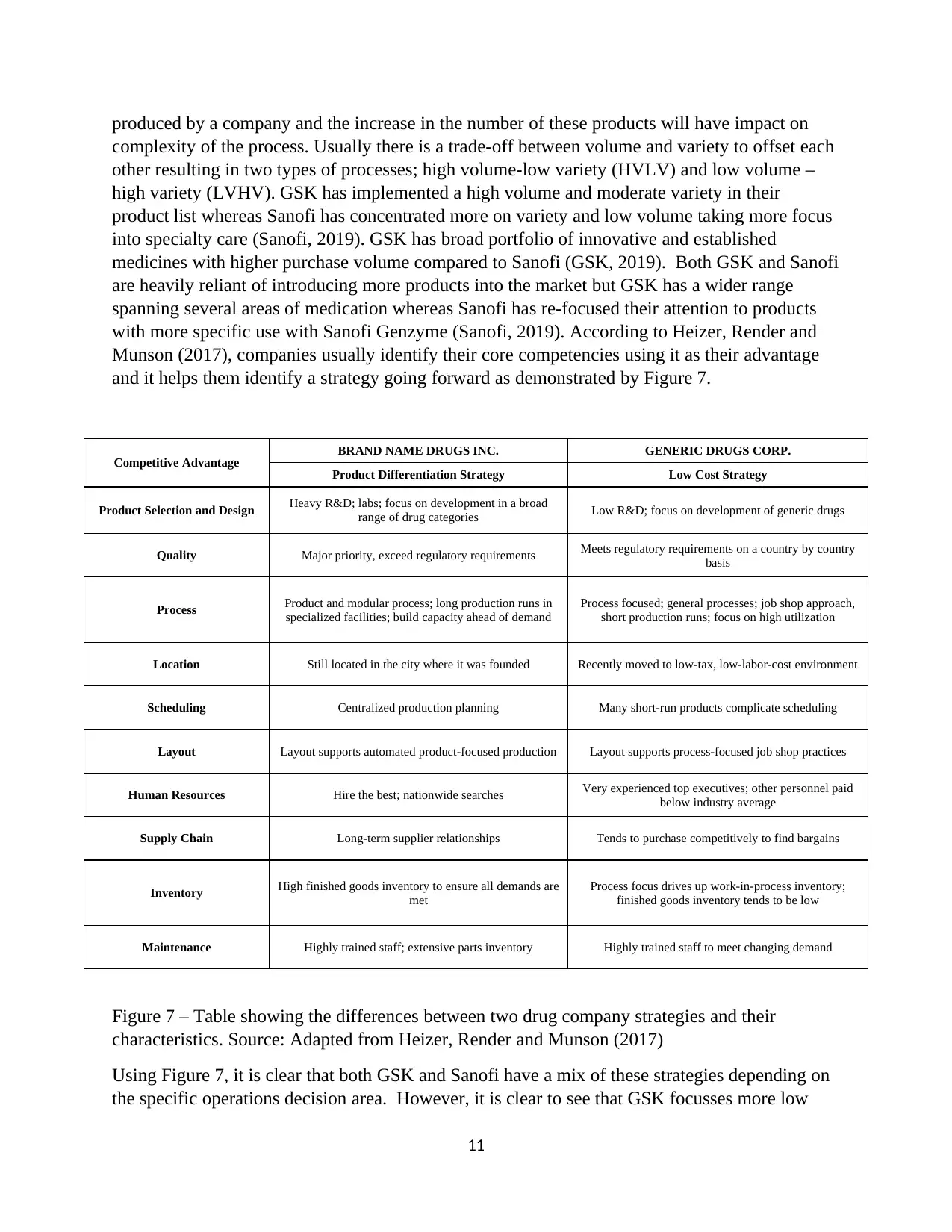
produced by a company and the increase in the number of these products will have impact on
complexity of the process. Usually there is a trade-off between volume and variety to offset each
other resulting in two types of processes; high volume-low variety (HVLV) and low volume –
high variety (LVHV). GSK has implemented a high volume and moderate variety in their
product list whereas Sanofi has concentrated more on variety and low volume taking more focus
into specialty care (Sanofi, 2019). GSK has broad portfolio of innovative and established
medicines with higher purchase volume compared to Sanofi (GSK, 2019). Both GSK and Sanofi
are heavily reliant of introducing more products into the market but GSK has a wider range
spanning several areas of medication whereas Sanofi has re-focused their attention to products
with more specific use with Sanofi Genzyme (Sanofi, 2019). According to Heizer, Render and
Munson (2017), companies usually identify their core competencies using it as their advantage
and it helps them identify a strategy going forward as demonstrated by Figure 7.
Competitive Advantage BRAND NAME DRUGS INC. GENERIC DRUGS CORP.
Product Differentiation Strategy Low Cost Strategy
Product Selection and Design Heavy R&D; labs; focus on development in a broad
range of drug categories Low R&D; focus on development of generic drugs
Quality Major priority, exceed regulatory requirements Meets regulatory requirements on a country by country
basis
Process Product and modular process; long production runs in
specialized facilities; build capacity ahead of demand
Process focused; general processes; job shop approach,
short production runs; focus on high utilization
Location Still located in the city where it was founded Recently moved to low-tax, low-labor-cost environment
Scheduling Centralized production planning Many short-run products complicate scheduling
Layout Layout supports automated product-focused production Layout supports process-focused job shop practices
Human Resources Hire the best; nationwide searches Very experienced top executives; other personnel paid
below industry average
Supply Chain Long-term supplier relationships Tends to purchase competitively to find bargains
Inventory High finished goods inventory to ensure all demands are
met
Process focus drives up work-in-process inventory;
finished goods inventory tends to be low
Maintenance Highly trained staff; extensive parts inventory Highly trained staff to meet changing demand
Figure 7 – Table showing the differences between two drug company strategies and their
characteristics. Source: Adapted from Heizer, Render and Munson (2017)
Using Figure 7, it is clear that both GSK and Sanofi have a mix of these strategies depending on
the specific operations decision area. However, it is clear to see that GSK focusses more low
11
complexity of the process. Usually there is a trade-off between volume and variety to offset each
other resulting in two types of processes; high volume-low variety (HVLV) and low volume –
high variety (LVHV). GSK has implemented a high volume and moderate variety in their
product list whereas Sanofi has concentrated more on variety and low volume taking more focus
into specialty care (Sanofi, 2019). GSK has broad portfolio of innovative and established
medicines with higher purchase volume compared to Sanofi (GSK, 2019). Both GSK and Sanofi
are heavily reliant of introducing more products into the market but GSK has a wider range
spanning several areas of medication whereas Sanofi has re-focused their attention to products
with more specific use with Sanofi Genzyme (Sanofi, 2019). According to Heizer, Render and
Munson (2017), companies usually identify their core competencies using it as their advantage
and it helps them identify a strategy going forward as demonstrated by Figure 7.
Competitive Advantage BRAND NAME DRUGS INC. GENERIC DRUGS CORP.
Product Differentiation Strategy Low Cost Strategy
Product Selection and Design Heavy R&D; labs; focus on development in a broad
range of drug categories Low R&D; focus on development of generic drugs
Quality Major priority, exceed regulatory requirements Meets regulatory requirements on a country by country
basis
Process Product and modular process; long production runs in
specialized facilities; build capacity ahead of demand
Process focused; general processes; job shop approach,
short production runs; focus on high utilization
Location Still located in the city where it was founded Recently moved to low-tax, low-labor-cost environment
Scheduling Centralized production planning Many short-run products complicate scheduling
Layout Layout supports automated product-focused production Layout supports process-focused job shop practices
Human Resources Hire the best; nationwide searches Very experienced top executives; other personnel paid
below industry average
Supply Chain Long-term supplier relationships Tends to purchase competitively to find bargains
Inventory High finished goods inventory to ensure all demands are
met
Process focus drives up work-in-process inventory;
finished goods inventory tends to be low
Maintenance Highly trained staff; extensive parts inventory Highly trained staff to meet changing demand
Figure 7 – Table showing the differences between two drug company strategies and their
characteristics. Source: Adapted from Heizer, Render and Munson (2017)
Using Figure 7, it is clear that both GSK and Sanofi have a mix of these strategies depending on
the specific operations decision area. However, it is clear to see that GSK focusses more low
11
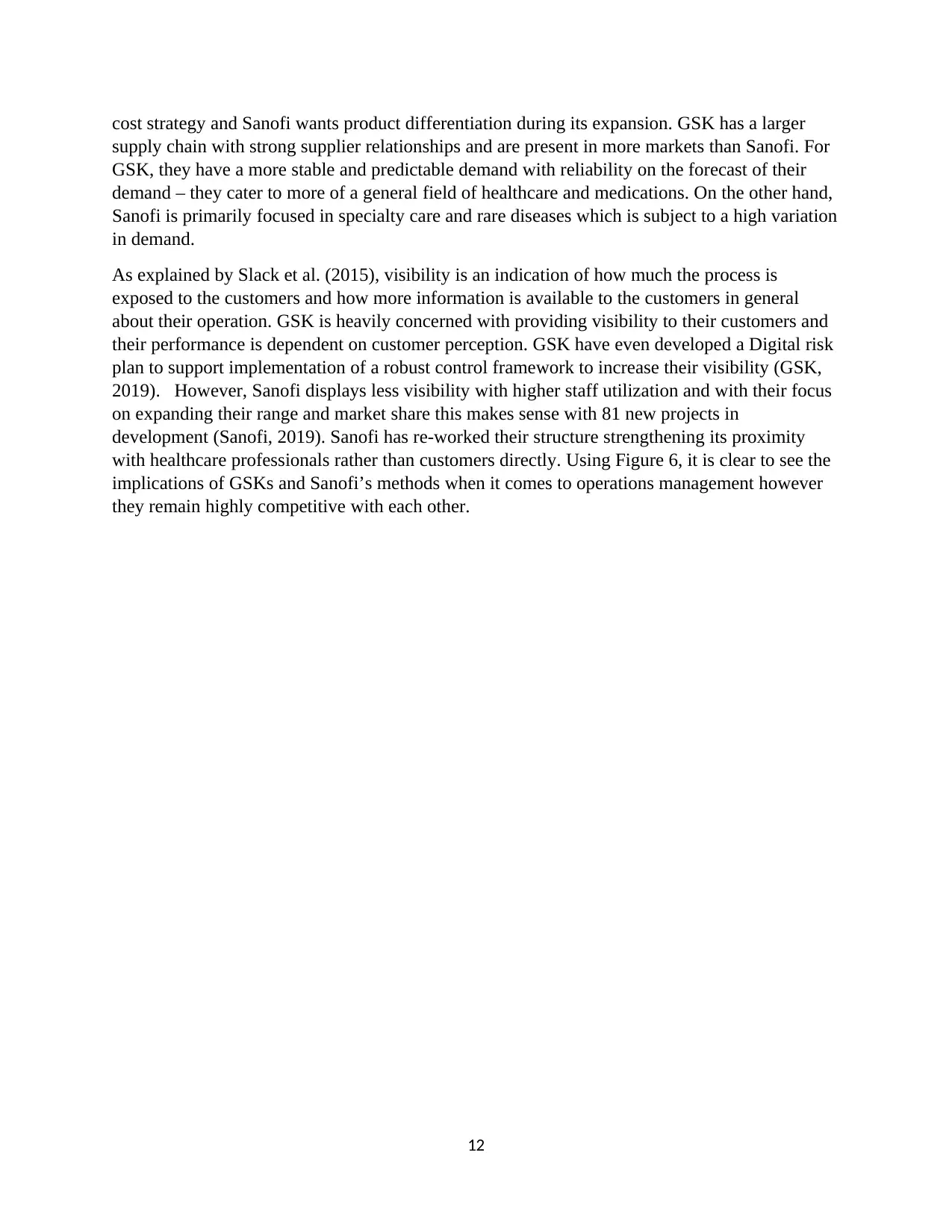
cost strategy and Sanofi wants product differentiation during its expansion. GSK has a larger
supply chain with strong supplier relationships and are present in more markets than Sanofi. For
GSK, they have a more stable and predictable demand with reliability on the forecast of their
demand – they cater to more of a general field of healthcare and medications. On the other hand,
Sanofi is primarily focused in specialty care and rare diseases which is subject to a high variation
in demand.
As explained by Slack et al. (2015), visibility is an indication of how much the process is
exposed to the customers and how more information is available to the customers in general
about their operation. GSK is heavily concerned with providing visibility to their customers and
their performance is dependent on customer perception. GSK have even developed a Digital risk
plan to support implementation of a robust control framework to increase their visibility (GSK,
2019). However, Sanofi displays less visibility with higher staff utilization and with their focus
on expanding their range and market share this makes sense with 81 new projects in
development (Sanofi, 2019). Sanofi has re-worked their structure strengthening its proximity
with healthcare professionals rather than customers directly. Using Figure 6, it is clear to see the
implications of GSKs and Sanofi’s methods when it comes to operations management however
they remain highly competitive with each other.
12
supply chain with strong supplier relationships and are present in more markets than Sanofi. For
GSK, they have a more stable and predictable demand with reliability on the forecast of their
demand – they cater to more of a general field of healthcare and medications. On the other hand,
Sanofi is primarily focused in specialty care and rare diseases which is subject to a high variation
in demand.
As explained by Slack et al. (2015), visibility is an indication of how much the process is
exposed to the customers and how more information is available to the customers in general
about their operation. GSK is heavily concerned with providing visibility to their customers and
their performance is dependent on customer perception. GSK have even developed a Digital risk
plan to support implementation of a robust control framework to increase their visibility (GSK,
2019). However, Sanofi displays less visibility with higher staff utilization and with their focus
on expanding their range and market share this makes sense with 81 new projects in
development (Sanofi, 2019). Sanofi has re-worked their structure strengthening its proximity
with healthcare professionals rather than customers directly. Using Figure 6, it is clear to see the
implications of GSKs and Sanofi’s methods when it comes to operations management however
they remain highly competitive with each other.
12
⊘ This is a preview!⊘
Do you want full access?
Subscribe today to unlock all pages.

Trusted by 1+ million students worldwide
1 out of 16
Related Documents
Your All-in-One AI-Powered Toolkit for Academic Success.
+13062052269
info@desklib.com
Available 24*7 on WhatsApp / Email
![[object Object]](/_next/static/media/star-bottom.7253800d.svg)
Unlock your academic potential
Copyright © 2020–2025 A2Z Services. All Rights Reserved. Developed and managed by ZUCOL.





